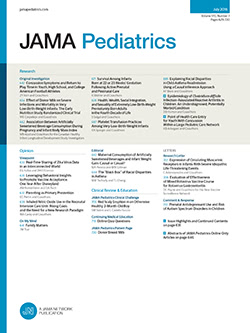Trends Over Time in Cognitive Outcomes of Children Born Very Preterm
IF 18
1区 医学
Q1 PEDIATRICS
引用次数: 0
Abstract
ImportanceProgress in perinatal care has improved survival for children born very preterm (VPT), but these children remain at higher risk of cognitive impairment compared with children born at term.ObjectiveTo synthesize cohort studies on childhood cognitive ability following VPT birth to investigate trends over time.Data SourcesAll studies from 5 previous meta-analyses of VPT birth and cognition published before 2019 were included, and PubMed, Web of Science, and PsycInfo were searched for new studies published up to June 2024.Study SelectionStudies reporting IQ scores of children (aged <18 years) born VPT (<32 weeks’ gestational age [GA] or birth weight <1500 g) with a term-born comparison group were included.Data Extraction and SynthesisTwo reviewers independently selected studies, extracted data, and evaluated study quality using a modified version of the Newcastle-Ottawa Scale. Unique cohorts were identified to avoid duplicate measures from studies on the same children.Main Outcomes and MeasuresThe standardized mean difference (SMD) of IQ scores between VPT-born and term-born children was calculated, and mixed-effects metaregression was used to investigate linear and nonlinear associations between median birth year and the SMD. The main analysis focused on cohorts with IQ measured between 4 and 7 years of age to allow comparison at similar assessment ages. Secondary analyses were conducted in all cohorts using IQ obtained at the latest assessment age.ResultsA total of 257 studies reported data from 131 cohorts of 25 746 individuals born from 1977 to 2016 (15 548 born VPT and 10 198 at term). In the 61 cohorts assessed at age 4 to 7 years (13 842 children born between 1977 and 2014 [8847 born VPT and 4995 at term]; mean [SD] GA, 28.2 [1.7] weeks for the VPT cohorts), IQ was lower for VPT-born children compared with term-born children (SMD = −0.88; 95% CI, −0.97 to −0.79). The linear model showed no association with birth year (β = −0.002; 95% CI,−0.012 to 0.008). Three types of nonlinear models were fit, with no nonlinear associations observed. Adjustment for GA and study characteristics did not change the results (β = −0.001; 95% CI, −0.013 to 0.011). Secondary analysis of 131 cohorts found a similar difference between VPT and term groups (SMD = −0.84; 95% CI, −0.90 to −0.79), with no time trend (β = 0.001; 95% CI, −0.005 to 0.007).Conclusions and RelevanceOn average, children born VPT had significantly lower IQ scores than term-born children, and this deficit did not decrease in studies conducted over 4 decades.早产儿认知结果随时间的变化趋势
围产期护理的进展提高了极早产儿(VPT)的存活率,但与足月出生的儿童相比,这些儿童仍有更高的认知障碍风险。目的综合队列研究VPT出生后儿童认知能力的变化趋势。数据来源纳入了2019年之前发表的5项关于VPT出生和认知的荟萃分析的所有研究,并检索了PubMed、Web of Science和PsycInfo,以检索截至2024年6月发表的新研究。研究选择研究报告了出生VPT(32周胎龄[GA]或出生体重[1500 g])的儿童(18岁)的智商分数,并纳入了足月出生对照组。数据提取和综合两名审稿人独立选择研究,提取数据,并使用修改版本的纽卡斯尔-渥太华量表评估研究质量。确定了独特的队列,以避免在同一儿童的研究中重复测量。主要结果和测量方法计算vpt出生和足月出生儿童智商得分的标准化平均差(SMD),并采用混合效应元回归研究中位出生年份与SMD之间的线性和非线性关系。主要的分析集中在4到7岁之间的智商测试,以便在相似的评估年龄进行比较。在所有队列中使用最新评估年龄获得的智商进行二次分析。结果共有257项研究报告了1977年至2016年出生的131个队列的25746名个体的数据(15548名VPT出生,10198名足月出生)。在61个年龄在4至7岁的队列中(1977年至2014年间出生的13842名儿童[8847名VPT出生,4995名足月出生];VPT组的平均[SD] GA为28.2[1.7]周),与足月出生的儿童相比,VPT出生的儿童智商较低(SMD = - 0.88;95% CI,−0.97 ~−0.79)。线性模型显示与出生年份无关(β = - 0.002;95% CI,−0.012 ~ 0.008)。拟合了三种非线性模型,没有观察到非线性关联。GA和研究特征的调整没有改变结果(β =−0.001;95% CI,−0.013 ~ 0.011)。对131个队列的二次分析发现,VPT组和term组之间存在类似的差异(SMD = - 0.84;95% CI,−0.90 ~−0.79),无时间趋势(β = 0.001;95% CI,−0.005 ~ 0.007)。平均而言,VPT出生的孩子的智商得分明显低于足月出生的孩子,而且在40多年的研究中,这种缺陷并没有减少。
本文章由计算机程序翻译,如有差异,请以英文原文为准。
求助全文
约1分钟内获得全文
求助全文
来源期刊

JAMA Pediatrics
PEDIATRICS-
CiteScore
31.60
自引率
1.90%
发文量
357
期刊介绍:
JAMA Pediatrics, the oldest continuously published pediatric journal in the US since 1911, is an international peer-reviewed publication and a part of the JAMA Network. Published weekly online and in 12 issues annually, it garners over 8.4 million article views and downloads yearly. All research articles become freely accessible online after 12 months without any author fees, and through the WHO's HINARI program, the online version is accessible to institutions in developing countries.
With a focus on advancing the health of infants, children, and adolescents, JAMA Pediatrics serves as a platform for discussing crucial issues and policies in child and adolescent health care. Leveraging the latest technology, it ensures timely access to information for its readers worldwide.
 求助内容:
求助内容: 应助结果提醒方式:
应助结果提醒方式:


